Brachychiton acerifolius



Fissured or Wrinkled
Fissured bark forms long narrow divisions causing separations. Wrinkled bark generally has smooth folded appearance that may be warty.
Conical / Pyramidal
When the outline of a shrub or tree forms a cone or pyramidal shape.This tree is deciduous or evergreen depending on the position and forms an erect pyramidal habit with maple-like lobed leaves that are dark glossy green. The bell-shaped red flowers appear in a cluster during late spring normally without the leaves.
Brachychiton acerifolius (A.Cunn. ex G.Don) F.Muell. is naturally found in Australia from Sydney to northern Queensland growing in coastal rainforests in sheltered positions. It prefers a deep loamy moist soil that is acidic to neutral, with a pH range from 6.0 to 7.0. It grows in a sunny to semi shaded protected position and is drought tolerant but frost and saline soil tender.
Illawarra Flame Tree is grown for its spectacular bright red flowers and its lustrous green foliage. It is used for street plantings or grown in parks and medium size gardens as a specimen or for shade. It has excellent contrasting flower colour with Jacarandas that occur at the same time. It has a vigorous growth rate initially and establishes as a small tree in 2 to 3 years. Under cultivation this tree normally attains only half its mature height, around 7 m and when young it can be grown as an indoor potted plant. Once established it has a low water requirement (Scale: 1-drop from 3), responding to an organic mulch and moist soil but will tolerate dry conditions.
I.D. 144
UK hardiness zone H1c
Climate zones 15 - 24, H1, H2
USDA Zone 9-12
Brachychiton (brak-ee-KY-ton) acerifolius (a-ser-ih-FOH-lee-us)
'Brachychiton': a short coat of mail (refers to the mass of short hairs that coats the seeds); 'acerifolius': leaves like an acer (maple).

Australia, (Sydney, NSW to northern Queensland)
Malvaceae (mal-VAY-see-ee)
Cotton, Mallows and Hollyhocks
This family consists of herbs, shrubs and rarely small trees and is normally recognisable by the Hibiscus-like flowers. The stems are fibrous and commonly covered in stellate hairs.
Distribution
This family of plants are found throughout the world in warm temperate, sub-tropical and tropical regions and extend to temperate climates but are absent in very cold regions. They are found in savanna or scrubland and along forest margins but are rare in rainforests as they demand sunlight.
Diagnostic Features
The simple leaves are arranged alternately and are petiolate, oblong with entire margins in drier regions or with palmately or various lobed margins and commonly orbicular in outline with stipules present.
The regular (actinomorphic) flowers are bisexual and have 3 to 5 sepals that are valvate, free or fused at the base and often epicalyx (bracts at the base of the calyx forming a second calyx-like). The 5-free normally showy petals are contorted or imbricate and fused at the base of the staminal column. They are normally solitary or are arranged in a small cyme or cluster in the leaf axils but may occur in terminal in raceme or panicle.
There are numerous stamens with filaments that are connate on the staminal column and surround the ovary and are attached to the base of the petals. The ovary is superior with 2 to many locular with one to many ovules per locular born on an axil placenta. The style is branched with the same number as the carpels and the stigmas may come in contact with each other.
The fruit is a dry loculicidal capsule or a schizocarp breaking into 5 or more mericarps commonly with awns, rarely berry-like with the glaborous or hairy seeds are commonly reniform and have little endosperm.
Note:
This family has recently undergone changes and now includes Tiliaceae, Bombacaceae and Sterculiaceae and has 10 subfamilies. This family is well known to the cotton industry with 2 species of Gossypium. There are many species grown as ornamentals for their attractive foliage and flowers with a few regarded as weeds. There are 115 genera and 2000 species worldwide with 160 species in Australia.
This plant tolerates between USDA zones 9a to 12a and grows to 15 m (50 ft)
Fahrenheit 20º to 55º F
These temperatures represent the lowest average.
Celsius -3.9º to 12.7º C

Attention
This plant was last revised on the 24/10/2019
The information displayed on this plant is based on research conducted in our horticultural library and from reliable online resources. We also make observations of the plant that we photograph, and all care is taken to ensure the details are correct.
All photographs and data are covered by copyright. Apart from any fair dealing for the purpose of private study, research, reference or review, as permitted under the Copyright Act, no part including images and text may be reproduced by any means without written permission. The information presented in the map is only indicative and may contain errors and omissions. All inquiries should be addressed to sales@plantfile.com attention Peter Kirkland.

Simple
The leaf that is not divided.
Lanceolate
Broadest at the centre, three or more times long as broad (Lance-shape).
Alternate
Leaves are arranged alternately along the stem.
Sinuate
A leaf margin that is equally concave and convex.
Apetalous
Without the second whorl of sterile appendages. No petals.
Cyme
Flowers that are both solitary and branching into solitary.| Jan | Feb | Mar | Apr | May | Jun |
| Jul | Aug | Sep | Oct | Nov | Dec |
The 20 mm (¾ in) wide apetalous flowers are a waxy open bell-shaped and are arranged in a terminal panicle-like cyme that is up to 300 mm (1 ft) long, appearing during late spring. It has irregular annual flowering numbers and performs better after a dry winter.
Note:
This tree only loses its leaves the year that it flowers and on occasions it may only loose half of its leaves producing a tree that is half in flower and half in foliage.

Follicle
A capsular fruit that splits open down one side only and normally contains one seeds. "| Jan | Feb | Mar | Apr | May | Jun |
| Jul | Aug | Sep | Oct | Nov | Dec |
The boat-shaped leathery follicle is up to 100 mm (4 in) long and is arranged in a pendant cluster. It contains yellow seeds that are surrounded by endosperm that has a honeycomb-like appearance. The pods are persistent on the tree for up to 1 year.
Illawarra Flame Tree is grown for its spectacular flowers and foliage. It is used for street plantings or grown in parks and gardens as a specimen or in rainforest settings. It has excellent contrasting colours with Jacarandas establishing in 2 to 3 years and can live up to 200 years. Under cultivation the tree normally attains only half its mature height and can be used in smaller garden settings. It can also be used as an indoor plant when young requiring a sunny position.
Note:
This plant is resistant to Phytophthora cinnamomi.
Normally there is no pre-treatment and fresh seeds should be sown when ripe or during spring. Maintain a temperature of 16º to 18º C. (61º to 64º F). Seeds germinate readily and should be pot up prior to planting out.
Grafted plants are more reliable and flower within 3 to 4 years.
Propagation by Seed (General)
Germination
In order for a seed to germinate it must fulfil three conditions.
1. The embryo must be alive (a viable seed).
2. The seed must have no dormancy-inducing physiological, physical or chemical barrier to germination; also the seed must be nondormant.
3. The seed must have the appropriate environmental requirements, water, temperature and oxygen.
The interaction between these requirements and dormancy is complex and may lead to different environmental requirements that avoid the dormancy of a seed.
Sowing Seeds in Containers
There are two general methods for germinating seeds.
1. Sowing seeds in a flat or germinating bed, through which seedlings are pricked-out then, transplanted into another flat with wider spacing or directly to an individual pot.
2. Sowing seeds by placing them in to flats with the appropriate spacing or into individual pots.
This method is normally carried out with medium to large seeds such as woody plants and plants that are difficult to transplant.
Seedling production normally occurs in a greenhouse / glasshouse, cold frames and on hot beds.
Method of Seed Sowing
Fine seed is sown in pots or flats that are no deeper than 70 to 80 mm. using a sterilised well-drained media (soil). Fill the container to 20 mm from the top and sprinkle sieved peat to 3 mm depth.
Press the media down level and firm with a piece of timber and then thoroughly moisten.
Mix the fine seed with washed sand and then sow thinly on the surface. These may be lightly covered with sand.
Larger seeds may be covered with media or a hole is dibbled and the seed is placed in the media.
Watering Methods
For watering you may either mist the containers from above or place the container in tepid water and allow the water to raise through the pot to the surface of the media, then drain away and do not fill to the top of the container.
Place a piece of glass over the pot and store in a protected warm environment (glasshouse).
Seeds germinate best in darkness so shade the containers if in direct sunlight.
After the seedlings have sprouted remove the glass and ease the seedlings into direct light.
When the seedlings are large enough prick them out and transplant into larger containers and place them in a shade house to harden off.
Many seeds have different methods of seed preparation for germination such as nicking or cutting the seed coat to allow water penetration, also placing seeds in hot water and allowing it to cool off.
This is particularly important as it is softening the seed coat.
Grafting and Budding
Grafting and budding have many different purposes.
1. It produces clones that are otherwise unobtainable through cuttings, layering and division.
2. To gain the benefits of certain rootstocks.
3. Changing cultivars of established plants.
4. It accelerates the reproductive maturity of seedlings in a hybridisation program.
5. Repairing damaged parts of trees.
Grafting is the joining two pieces of living tissue as so they grow into a single living plant there is 5 requirements for a successful graft.
1. The stock and the scion must be compatible.
2. The scion and stock must have intimate contact in the cambium region and held together by wrapping or wedging.
3. The graft must be carried out when the stock and scion are in the right physiological stage. A dormant bud and a stock that is capable of forming a callus.
4. Protect all cut areas after the grafting operation with wax or tape.
5. After-care of the plant by the removal of shoots from below the graft.
Tools and Materials Required for Grafting.
1. Knives
There are two types of knives, budding and grafting either folding or a fixed blade. A budding knife may do both jobs if required. The knife must be razor sharp and is usually honed on an oil stone at a 20-deg angle.
2. Grafting Waxes
The ideal grafting wax should adhere well and not wash off, crack, chip and still be pliable enough to allow the callus to grow. A darker wax is often used as the sun will warm it and thus it remains pliable.
When applying the hot wax be careful that the temperature is not extreme as to damage the living wood.
The wax is normally heated on a small burner and applied with a brush and there is an aerosol form available for small jobs.
3. Wrapping and Tying Materials
String is a simple material to tie a graft in place. Waxed string is good as it adheres to the wax covering. The string should be strong enough to hold the scion in place but weak enough to be broken by hand.
Tape is cloth, adhesive or PVC. The nurseryman's adhesive is the most convenient as it can be used for tiering and sealing but do not apply to many layers as this will not disintegrate quickly and cause constrictions.
Grafting Methods
Whip Grafting
This method is used for smaller material. The scion should contain 2 to 3 buds with the graft occurring in the smooth internode area.
The cut that is made at the top of the stock should be the same as the cut on the bottom of the scion.
These should marry together evenly with a reverse cut that forms interlocking tongues.
If the scion is smaller than the stock it should be placed to one side. After the graft is complete it is secured by wrapping or tying then waxing.
Splice Grafting
This is the same as whip grafting except there is no tongue only a slanted cut on both stock and scion.
Side Graft
There are several methods for this but normally it involves the insertion of the scion into the side of the stock that is normally larger.
Cleft Grafting
This is an old method that works well for straight grained plants. It involves the cutting of the stock are right angles and splitting it with a large knife and inserting the prepared tapering wedged scion on the cambium layer. After the graft is complete it is sealed with wax.
Wedge Grafting
This type of grafting is carried out during late winter to early spring. The scion used should be 10 to 13 mm long and 8 to 12mm thick with a wedge shape base that matches the stock cavity.
Using a large knife a wedge should be cut in to the side of stock as to create a 2 cm (1/16 in) long V shape which can be nocked out to form a cavity. More than one cut may be made around the edge of the stock to allow multiple grafts.
Matching the cambium layers on the stock and scion gently tapped into place tilting slightly outwards to ensure that the cambium layers cross.
After grafting is completed all exposed areas are to be covered in grafting wax to seal off.
Budding
This is a form of grafting that has only one bud and uses only a small section of the bark. It is carried out by slipping bark that is actively growing. The T-budding is a quick and reliable method and is widely used in commercial production.
Methods of Budding
1. T-Budding.
This commonly used method is carried out by making a vertical cut about 2.5 cm (1/16 in) long in the stock. A horizontal cut is then made at the top of the vertical cut and runs one third around the stock. Twist the knife to open the two flaps of bark.
Preparing the Bud
Use a sharp knife and slice 12 mm (½ in) below the bud up and under at a depth of about 25 mm (1 in) finishing just above the bud then a horizontal cut is made through the bark to release the bud.
Inserting the Bud into the Stock
The bud is inserted into the stock by pushing down and in side the T cut until the two horizontal cuts are even. The bud union is then tightly tied.
2. Inverted T-Budding.
This method is used in areas of high rainfall or where a plant weeps a lot. The budding method is the same as a normal T-Bud but has the advantage of draining well. It is important to insert the bud with the correct orientation.
2. Patch Budding.
Patch budding is carried out during late summer or spring. It involves removal of a piece of bark that is replaced with a bud of equal size. A special double bladed knife is used and this is normally carried out on larger plants.
Method of Patch Budding
1. The stock is cut about one third around with two parallel horizontal cuts using a double bladed knife.
Vertical cuts join the horizontal and the piece of bark is removed.
2. The bud is prepared in the same method and is removed by sliding it off from one side.
3. The bud is then inserted into the stock and may require trimming to form a tight fit.
4. The union is then wrapped or covered with wax revealing only the bud.
There are many variations of the patch bud,
Flute Bud
Ring Bud
I-Bud
Chip Budding
Chip budding is normally used before growth starts with small wood in early spring and as growth tappers during autumn.
Method of Chip Budding
1. Make a cut at 45 deg down and into the stock to a quarter the thickness. A second cut is made 25 mm (1 in) above going down and in to meet the base of the first cut.
2. The bud is cut in the same method creating a wedge that is the same size as the stock cut.
3. Remove the chip from the stock and place the matching bud into the stock.
4. Wrap the union with tape and cover all exposed cuts.
PEST
NAME
Kurrajong leaf-tier, Bag Moth
Lygropia clytusalis
ORDER
Lepidoptera
FAMILY
Pyralidae
Description of the Pest
The pale green brown larvae of this moth are gregarious and very active, living in a bag of webbed leaves (the silk-tied leaves also account for the common name, "bag moth"). The adult moth has pale, orange and black-banded wings, with a wingspan of 25mm.
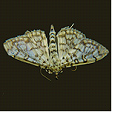
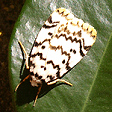
Appearance and Distribution of the Pest
Larvae are active from mid summer through autumn, regardless of the climatic conditions. They are found throughout eastern and inland Australia.
Life Cycle
This insect has a Holometabolous life cycle, ie. When metamorphosis is observed during the pupal stage.
The larvae pupate inside the bag.
Period of Activity
Larvae shelter in the bag, where they feed during the day; they leave their shelter to continue feeding at night.
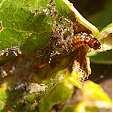
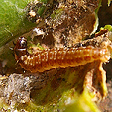 Larvae
Larvae
Damage Caused
Larvae eat the leaves and produce bags which, in large numbers, have an unsightly appearance.
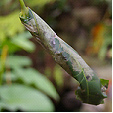
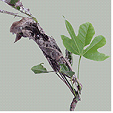
Susceptible Plants
Kurrajong (Brachychiton populneus) and Illawarra Flame trees (Brachychiton acerifolia).
Cultural Control
Remove the bagged leaves, and destroy off-site.
Biological Control
There is no natural control.
Chemical Control
Systemic insecticides may be effective.
Note
Always read the label for registration details and direction of use prior to application of any chemicals.
PEST
NAME
Looper Caterpillars
Various Looper Caterpillar Species
ORDER
Lepidoptera
FAMILY
Noctuidae
Description of the Pest
The looper is so-called because of the larvae's characteristic "looping" movement: the back legs move forward behind the front legs, causing the body to arch into an inverted "U" shape. They vary in colour and size; Brown Looper (Lophodes sinistraria) can grow to 50mm long, glossy black with yellowish bands then maturing to brown and found in coastal sub-tropical regions.
Green Wattle Looper (Thalaina species) adult is a small white moth with a wing span of 40mm and the lava is a slender green caterpillar with a rounded head. It is commonly found on ferny leaves Acacia species and when it is not feeding it takes up an erect position imitating a twig growing at an angle. It is difficult to detect and normally not requiring control.
Grevillea Lopper (Oenochroma vinaria) is a slender caterpillar that is greyish with orange bands and has two thorn-like projections on its back towards the head that it uses in a defence position. It is hairless with mottled orange colouring and grows to 80mm long. The adult moth (pink belly moth) has a wing span up to 60mm across and is pinkish.
Brown Looper (Lophodes sinistraria) are black with yellowish bands at first maturing to brown growing to 50mm long. It is a solitary feeder eating mature leaves and are found in tropical to sub tropical regions.
Appearance and Distribution of the Pest
Many species are found throughout Australia from tropical to temperate regions.
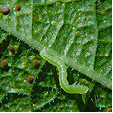
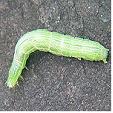
Life Cycle
These insects have a Holometabolous life cycle, ie. When metamorphosis is observed during the pupal stage.
Period of Activity
Most active during the warmer months the larva feed generally in the early morning or in the evening. Caterpillars are also active during cloudy days.
Damage Caused
Larvae are voracious feeders, skeletonising leaves or stripping them to the midrib preferring new growth.. Certain species feed solitary while others in groups.
The Grevillea Lopper feeds solitary or in groups defoliating small areas in species such as Lambertia and Grevillea.
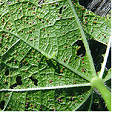
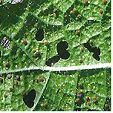
Susceptible Plants
A wide range of native and exotic plants are attacked, depending on the species of looper. Plants with soft-textured foliage (eg vegetables, some indoor plants) are preferred. The Brown Looper is found on Acmena smithii, Waterhousea floribunda and Macadamia species.
Tropaeolum and Calendula species are attacked by the Cabbage Looper (Trichoplusia ni), which feeds on the leaves and flowers.Tropaeolum species are also attacked by the caterpillar (Pieris rapae), which eats the foliage.
Cultural Control
Small numbers may be removed by hand.
Biological Control
Birds and other predators reduce numbers.
Chemical Control
The plant may be sprayed using Carbaryl. During heavy infestations this method is effective.
Note
Always read the label for registration details and direction of use prior to application of any chemicals.
PEST
NAME
Caterpillars (General)
Various species
Description of the Pest
There are many types of caterpillars from moths or butterflies, cutworms, bag moths, case moths, leaf rollers leaf skeletonises. The larvae generally eat leaves, seeds, flowers or buds by chewing out pieces. The size of the piece will depend on the size of the caterpillar and generally they are voracious eaters. The method of eating varies such as the leaf skeletoniser which leaves a network of veins or whole leaves are consumed.
The larvae have mainly 4 or 5 pairs of prolegs except Loopers which have 2 -3 pairs of prolegs. The number of prolegs can help in identifying the insect.
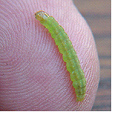 Small and Large Types
Small and Large Types 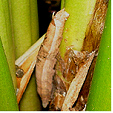
Casuarina Moth (Pernattia exposita) is gregarious, brown with a large head and tufts of hairs that line the slender body. It grows to 25 mm long and forms a tightly woven cocoon on the side of branchlets. The large female adult moth has a stocky body and generally slow moving, the male is smaller.
The larvae cause extensive damage to A. littoralis, A. stricta, C. cunninghamiana, C. glauca, and C. equisetifolia.
The hairy larva feed on the 'leaves" phyllodes, and stems, this can lead to ringbarking and death of branches.
Monitoring
Place sheets on the ground and disturb (shake) the tree for the larva drop to the ground on silken threads.
Spruce Budworm (Choristoneura fumiferana) is a reddish brown with a yellow stripe on its side and chews on the opening buds and the needles of the host. The adult moth is dull grey with brown bands and spots on the wings, appearing in early summer. The larva is very destructive in northern hemisphere coniferous forests.
Banksia Moth (Danima banksiae) is a caterpillar up to 60 mm long and is brown with black and white markings on its sides and when disturbed it arch backwards and reveal an extruded red underside, close to its head. The grey adult moth has an orange coloured body with a wing span that is up to 80mm across with black and white markings.
Banana moth (Opogona sacchari) is in the order Lepidoptera. This nocturnal moth as a wing span up to 25 mm wide and is bright yellowish brown with a dark brown spot on the wings. It has a life cycle that lasts approximately 3 months with the eggs hatching in 12 days and the whitish larva with a reddish brown head is up to, 26 mm long, and lives for 50 days at 15° C. In warmer climates life cycle is quicker with up to eight generations per season. The female moth uses a ovipositor to lay up to 500 eggs in groups of five amongst the crevices of the plant. The voracious larvae tunnel into the plant, avoiding light. In bananas it infests developing fruit and in ornamental plants it prefers the fleshy stems, particularly in cacti, begonias, African violets and is also a serious pest of Pritchardia and Chamaedorea species. Symptoms include tunnelling activity, which may be difficult to see then dead areas appear on the stems. As the caterpillars destroyed xylem tubes leaves begin to wilt and the plant may collapse and die. In European countries it is a glasshouse pest that is controlled chemically.
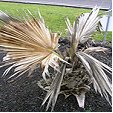 Pritchardi species
Pritchardi species 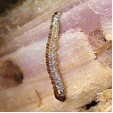 Banana moth larvae
Banana moth larvae
European Pine Shoot Moth (Rhyacionia buoliana) lays eggs on Pinus species during late spring on the new buds and the emerging caterpillars in late summer feed on the shoots causing them to fold and become deformed, eventually dieing. A major problem in the pine forests of the northern hemisphere
Large Grass Yellow Butterfly (Eurema hecabe) is a small attractive yellow butterfly. with a wing span of 40 mm that lays its eggs on the feathery leaves on Acacia species such as A. baileyana, (Cootamundra wattle), A. spectabilis (glory wattle). Other plant foods include Cassia spp, Caesalpinia spp, Senna spp. Albizia julibrissin (silk tree) A. paraserianthes (Albizia) sp Aeschynomene sp (Budda pea), Indigofera australis (Australian indigo's), Sesbania cannabina (yellow pea-bush), Senna surattensis (Glossy shower), Leucaena leucocephala (wild tamarind).
The small lava are up to 15mm long, green with white lateral bands and feed on the leaves at night in small groups, hiding under the leaves during the day. Large infestations may strip trees and require control. The larva of this insect does not feed on grasses. The adults are important pollinators of many Australian native plants. Various sub species of this insect are found through out Asia.
Gypsy Moth (Porthetria dispar) lava is a hairy grey caterpillar that is marked with blue and red dots along its back and can grow to 75mm long. It is capable of defoliating large trees and is a major problem for several species. A major problem in the northern hemisphere.
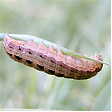 Lawn Armyworm
Lawn Armyworm
Lawn Armyworm (Spodoptera mauritia) is a plump, smooth caterpillar that is darkish brown to black with multiple stripes and pattens along its body. It can grow to 50mm long and tapers from the head. They are gregarious and move around in groups, like an army. If disturbed the larva drop to the ground and curl up, "faking death" The larva pupate in the soil. They are a pest of grasses and monocotyledon crops mainly.
This insect is also found throughout Asia.
Monitoring
Drench a known area with old fashion soap 2L / 1000 cm 2. Note the numbers of larvae emerging.
Oblique-banded Leaf Roller (Choristoneura roseceana) lava feeds on the leaves and forms a nest by drawing the leaf margins together using silk threads. The adult moth is up to 25mm across the wingspan and is reddish brown with three darker brown bands across the wings. This is a problem in the apple growing areas of North America. It feeds on Maples, hawthorns, crab apples, Blackberry (bramble) and raspberries.
Red Humped Caterpillar (Schizura concinna) is a lava has a red head and humps with yellow and black strips on the body. It grows from eggs that were laid on the underside of leaves by the adult greyish brown moth that has a wing span up to 30mm across.
Tailed Emperor Caterpillar (Polyura pyrrhus spp. sempronius) adult is a large butterfly with a wing span up to 110 mm with four long tapering tails and the rear of the wings. The fleshy caterpillar with four obvious backward facing horns on a shield shape head. It is dark green with yellowish bands and transversal stripes over its back and grows up to 80 mm in length.
It is commonly found solitary or in small groups. Found over much on mainland Australia. The adults are attracted to overripe fruits they become drunk on this and so are easy to capture. The larvae feed on many plants including, Acacia baileyana (Cootamundra Wattle, A. spectabilis (Glory wattle), Delonix regia (Poinciana), Cinnamomum camphora (Camphor laurel) Robinia pseudoacacia (Black or false locust) Lagerstroemia indica (Crepe Myrtle), Argyrodendron actinophyllum (Black booyong), Celtis spp (Hackberry), Brachychiton spp (Kurrajongs) Gleditsia triacanthos (Honey locust).
Verbena Moth (Crambodes talidiformis) lays its eggs on the outside of the plant and the small green caterpillar that attacks seed pods by entering and eating the contents. It half emerges while pupating appearing as a small brown bump circled by a black ring. Native to North America
White Tussock Moth (Hemerocampa leucostigma) produces lava that is up to 50mm long. It has a red head with a yellow body that is marked in black and has four tufts of hair. The caterpillars pupate on the branches and the eggs laid by the adult moth overwinter on the trunk and are covered in a white waxy material. They are found on Aesculus species. A pest in North America of Oaks.
Life Cycle
This insect has a Holometabolous life cycle, i.e. it has a larval and a pupal stage.
Distribution of the Pest
Many species are found throughout the world from tropical to temperate regions and most of the adults are capable of by flying
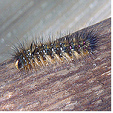 Many hairy caterpillars can be irritating
Many hairy caterpillars can be irritating 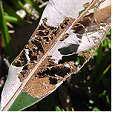 Leaf Skeletonised
Leaf Skeletonised
Period of Activity
Most active during the warmer months from spring to autumn.
.
Damage Caused
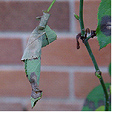 Leaf Rollers
Leaf Rollers
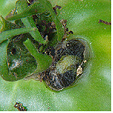 Caterpillar Inside a Tomato
Caterpillar Inside a Tomato
Susceptible Plants
A wide range of native and exotic plants are attacked and can be a major problem in commercial crops or turf grasses. Plants with soft-textured foliage (eg vegetables, some indoor plants) are preferred, but trees and shrubs are commonly attacked.
Malvaceae Abutilon spp, Hibiscus spp and other members of the family are attacked by the castor oil looper, Croton caterpillar (Achaea janata) which feed on leaves. The tip borer Cotton tipworm (Crocidosema plebejana), Rough bollworm (Earias huegeliana) which feeds on young stems, flowers and seeds. A leaf miner (Phyllonorycter spp)
Acer saccharinum and Fagus species are attacked in North America by the Maple Leafcutter (Paraclemensia acerifoliella) that forms a small cocoon in leaves that it skeletonises.
In Australia Case moths and Painted apple moths (Teia anartoides)
Ailanthus altissima is attacked by the Cynthia Moth (Samia cynthia) light green lava, which eats leaves and the Ailanthus Webworm (Atteva aurea) which are olive-brown caterpillars that form web nests in the leaves.
Antirrhinum species are attacked by the Leaf Tier (Udea rubigalis) lava. This caterpillar eats pieces out of leaves and binds them together forming a nest. It is more commonly found in glasshouse culture.
Berberis species may become infested with the Barberry Worm (Omphalocera dentosa). This small caterpillar is black with white spots, up to 14mm long and feeds on young shoots and leaves. It also binds the shoots with a silken thread to form a nest.
Betula species are attacked by the Leaf Skeletonizer (Bucculatrix canadensiella). The small adult moth has brown wings with a whitish underside and its yellow green, 7mm long lava skeletonise the undersides of the leaf turning it brown.
Brachychiton, Senna and feathery-leaved Acacia species are attacked by the Tailed Emperor Caterpillar, particularly in dryer periods.
Catalpa species are attacked Catalpa Sphinx (Ceratomia catalpae). This large yellow and black Caterpillar grows to 76mm long and attacks the leaves. Large infestations can completely stripped a tree and control is carried out by spraying.
Calendula and Canna species are attacked by the Woollybear Caterpillar (Diacrisia virginica) which has yellow and black lines down its body is up to 50mm long and eats the leaves or flower buds. In Canna species the chewed holes tend to be in a straight line across the leaf.
Celtis species are attacked by the Spiny Caterpillar (Nymphalis antiopa) which is reddish, up to 50mm long and feeds on the leaves at the top of branched in groups.
Cheiranthus species are attacked by the Diamond-backed Moth (Plutella maculipennis) lava, which is a small green caterpillar to 14mm long that feeds on the underside of leaves and may form a shot hole appearance. It forms a small cocoon to pupate in and in cooler climates it may be found in glasshouses.
Cotinus, Fraxinus, Betula, Cornus, Crataegus, Aesculus, Tilia, Acer, Quercus and Populus species are susceptible to attacked by the Oblique-banded Leaf Roller (Archips rosaceana)
Iris and Antirrhinum species are attacked by Verbena Moth.
Picea, Abies, Tsuga and Pinus species are attacked by Budworm commonly found in the northern hemisphere.
Populus and Carya species are attacked by the Red Humped Caterpillar which chews the leaves.
Quercus species are attacked by several caterpillars including Saddleback Caterpillar (Sibine stimulea) and Datana Caterpillar (Datana ministra) that feed on the leaves.
Samanea saman is attacked by several caterpillars (Ascalapha odorata, Polydesma indomita and Melipotis indomita). These caterpillars defoliate the tree but cause no long term problems.
Spiraea, Fraxinus, Betula, Cornus, Crateagus, Acer, Quercus and Populus species are attacked by the Oblique-banded Leaf Roller.
Ulmus, Salix, Crateagus, Tilia, Quercus and Populus species, Pseudotsuga menziesii are attacked by the Gypsy Moth (Porthetria dispar).
Ulmus species are attacked by the Spring Cankerworm (Paleacrita vernata), which chews the leaves during spring and the Fall Cankerworm (Alosphila pometaria), which also eats the leaves during autumn. Ulmus species are also attacked by several caterpillars including the lava of the Leopard Moth (Zeuzera pyrina) and the Tussock Moth (Hemerocampa leucostigma).
Cultural Control
Small numbers may be removed by hand and squashed while others species such as the Casuarina Caterpillar drop to the ground when disturbed by hitting with a stick or shaking the plant. On the ground they can be squashed or collected and placed in a bucket of soapy water. All rubbish around plants and glasshouses should be cleared as certain moths overwinter in such places.
Biological Control
There are many natural predators that reduce numbers including birds, lizards, frogs; other predators are wasps, viruses, and fungi.
Chemical Control
The small plant may be sprayed using Pyrethrum-based insecticide to reduce numbers or dusted with an equally environmental friendly chemical. In severe cases crops may be sprayed with Carbaryl.
Note
Always read the label for registration details and direction of use prior to application of any chemicals.
PEST
NAME
Borer (General)
Various Borer Species
ORDER
Various
FAMILY
Various
Description of the Pest
Generally the larvae bore holes into the heartwood, sapwood or down the centre of twigs though not all borers attack trees. These tunnels may be small or large, deep or shallow and when they emerge from their tunnels at night, they feed on the surrounding tissue. Entrance holes may be covered by a layer of chewed wood fragments ("frass"), silk webbing or exposed and the tunnels may be solitary or form galleries. Certain species attack only twigs and young shoots, while others attack the trunk or roots.
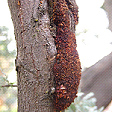 Fruit tree moth borer damage
Fruit tree moth borer damage
The adults female of a fruit tree moth borer normally deposits eggs in damaged areas of the bark or where there is and existing active site. The larvae vary but generally they are creamy to brown, thick soft grub-like reddish brown, and up to 40mm in length.
The adults are white, satiny moths with 40-60mm wingspans with their black abdomens fringed with orange-brown hair or beetle lava that has been deposited in the bark or twigs then tunnels the host.
American Plum Borer (Euzophera semifuneralis) lava is pinkish white to brownish green and attacks the inner bark and cambium region of the tree causing premature death. It is normally found on Platanus orFraxinus species and may also infest many species of fruit trees.
Apple Root Borer (Leptopius squalidus) female adult is a weevil to 20mm long and feeds on the leaves and the plump, legless grub-like lava feeds on the roots of the same host forming tunnels in the deep roots. It is commonly found on Acacia and Eucalyptus species damaging the anchorage of the plant.
Banksia Borer (Cyria imperialis) adult is a black beetle with yellow markings on its wing covers growing to 15mm long. The thickish legless lava is white, tapering from the head and forms flattened tunnels into the heartwood of the host.
Bronze Birch Borer (Agrilus anxius) is a bronze coloured beetle up to 14mm long and lays eggs in crevices in the bark. The legless white larva grows to 20mm long and feeds on the sapwood girdling the branch with flat irregular galleries.
Cedar Tree Borer (Semanotus ligneus) is a black beetle with orange and red markings on its wing covers and grows to 12mm long. The larva feeds on the sapwood of Sequoia, Thuja species and Pinus radiata with curved tunnels that may girdle branches.
Chestnut Borer (Agrilus bilineatus) adult is a tiny slender, blackish green beetle up to 8mm long emerging during spring. The small white larvae have a flat head and are up to 15mm long, forming galleries under the bark of Quercus species.
Cypress Bark Beetle (Phloeosinus cupressi) adult is dark brown with a blackish head, oblong in shape up to 3mm long. The tiny beetles tunnels under the bark of the host and deposits eggs. After hatching the tiny 4mm long, legless larvae bore into the heartwood damaging the tree. After they pupate in the tunnel they emerge through small round holes, commonly many together on the trunk. Damaged trees show signs of browning and dead leaves in the upper branches or falling damage twigs. Cupressus species are particularly vulnerable to attack.
Deodar Weevil (Pissodes nemorensis) is brownish with an obvious snout feeding on the cambium layer and deposits eggs in the bark of the leader and branches. The white lava tunnel the wood eventually killing the leader.
European Corn Borer (Pyrausta nubilalis) is a small moth that lays up to twenty eggs on flower buds. The young flesh coloured larvae mature to a reddish brown and each of its segment has four, spined dark spots.
Elephant Weevil (Orthorhinus cylindrirostris) is a grey or black insect up to 20mm long and lays eggs in the bark near the base of stressed trees. The larva tunnels its way through roots or trunks depositing frass as it goes, then emerging from a second round hole. The adults eat strips from the leaves, normally not bothering the plant.
Elm Borer (Saperda tridentate) adult is a greyish beetle with red bands and black spots on its wing covers and is up to 12mm long. The eggs are laid on the bark and the whitish lava tunnels into the bark and sapwood where it overwinters. It is normally found on Ulmus species.
Iris Borer (Macronoctua onusta) is born from a grey moth with a wing span up to 30mm across, and lays eggs that overwinter in old leaves and debris. As the leaves emerge the eggs hatch entering the leaves at the base, visually forming tunnels and growing to 30mm long. In the later season flower buds may be attacked. Both flowers and leaves eventually turn brown and die.
Lilac Borer (Podosesia syringae) adult is a wasp-like moth that produces pure white lava with a brown head that are up to 25mm long. It initially feeds in the sapwood causing wilting before tunnelling the hardwood making the branches brittle. Evidence of frass is found at the tunnel entrance and secondary fungal attacks infect the holes. Normally found on Syringa species.
Locust Borer (megacyllene robiniae) adult is a black beetle with golden spots, up to 20mm long and produces a small larva that tunnels galleries into the sapwood causing a blackish discolouration. Robinia species are normally attacked.
Mottled Borer (Cryptorhynchus lapathi) attacks Salix species. The adult beetle is black up to 10mm long and the lava bore into the surface of the stem causing swollen growth. Salix species are attacked.
Murry Pine Borer can be two species (Diaoxus erythrurus) and (Diaoxus scalaris). The adults are glossy green-brown beetles that are up to 20mm long and the white grub-like lava is legless, tapering from the head. They tunnel into the sap or hardwood of the trees forming connecting galleries causing ringbarking and creating brittle branches, commonly fond on Callitris species.
Peach Borer (Sanninoidea exitiosa) is a larva that tunnels roots causing gummosis that is mixed with frass at the crown just below soil level. The affected Prunus species produce yellowish leaves and grows poorly. There is another borer, Lesser Peach Borer (Synanthedon pictipes) which attacks any part of the plant from the trunk to the branches and is found on several Prunus species.
Puriri Moth (Aenetus Virescens) a New Zealand short lived moth that grows with a wing span of over 100mm (4in) wide laying eggs on the forest floor at night during spring. The caterpillars grow to 100mm long feeding on leaves and then ascending into the trees and entering the cambium layer up to 150mm deep forming a characteristic '7'-shape burrow that is concealed by frass. The caterpillar may live for 7-years before pupating and collectively they ring bark branches or trunks causing dieback.
Many New Zealand plants including Nothofagus solandri, Pomaderris spp.and ornamentals such as Quercus spp. Betula pendula, Salix spp. Populus spp. Acer spp. Citrus limon and Paulownia spp. are attacked. Control is difficult and generally the plants tolerate attack.
White Pine Weevil (Pissodes strobi) lava feed on the inner bark and sap wood of terminal shoots causing ringbarking and death of the shoot. The reddish brown beetle up to 6mm long is mottled in white and emerges during early summer then lays yellowish lava that are up to 9mm long.
Scribble Moth (Ogmorgraptis scribula) is a grey moth up to 0.4mm wide and produces a cream to brown larvae that is also about 0.4mm long and tunnels in the bark causing a scribble effect. This normally has no detrimental effect on the tree.
Spotted Hemlock Borer (Melanophila fulvoguttata) adult is a colourful metallic beetle with yellowish red spots on the wing covers and lays eggs in cracks in the bark. The white lava is up to 14mm long and forms galleries in the bark and sapwood of the host.
The large Swift Moth and Wood Moths can have a wing span up to 250mm wide and produce large larva that are grub like up to 150mm long, some with horny plates on the thorax. These larvae bore tunnels that are up to 30mm across straight through the heartwood of the host plant. The larvae may live in the tunnel for up to five years before pupating.
Red Cedar Bark Beetle (Phloesinus dentatus) is a small beetle up to 3mm long and lays its larva in excavations in the bark. When the larva emerges they bore galleries in the bark and tend to be more prevalent in stressed or recently transplanted plants.
Vegetable Weevil (Listroderes difficilis) is found during cooler weather (spring or autumn). The adult brown beetle up to 19mm long with a "V" mark on its back and the eggs are laid in the soil around the base of the host plant. The cream coloured lava emerges in spring after rain and feed on the lower leaves forming irregular holes or chewing holes in stems. The lava also feed on fleshy roots boring holes into carrots. Both the adults and lava cause damage, feeding on the plant during the night and resting at the base or under ground during the day. The lava pupates in the soil over winter.
Wattle Web-covering Borer (Cryptophasa rubescens) adult is a satin coloured moth that is up to 50mm across and deposits green fleshy lava that is up to 35mm long. The lava forms shallow tunnels in the bark and sap wood of the host and camouflages it with chewed wood and faeces that is webbed together. Commonly seen attacking the branches on Acacia species.
Life Cycle
These insects have normally have a Holometabolous life cycle. But some borers such as Termites have a Hemimetabolous life cycle.
Eggs are laid singly or in groups, in damaged areas of the bark and branch. Larvae shelter in tunnels they create in the wood and some species may take many years to pupate and emerge as an adult. This may take place in live or dead wood. Other species such as Corn Borer can have up to two generations per year.
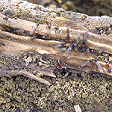 Termites and their damage
Termites and their damage
Distribution of the Pest
Borers are found throughout the world with many species found in Australia both on the coast and inland.
Period of Activity
Varies with the insect concern. Many larvae can be active for many months. Termites are active all year.
Damage Caused
Most damage appears on branches or trunks where the larvae feed on the soft tissue and extensive feeding may cause ring-barking. Normally plants survive borer attack but repetitive attack will cause the death. Certain species are a serious pest in plantations or monocultures such as the Pine Bark Weevil, and the Sirex wood wasp.
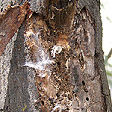 Typical borer damage by a moth larva
Typical borer damage by a moth larva
Chestnut Borer feeds on the sap wood ringbarking large branches and overwinters in the tunnels.
Corn Borer feeds on flower buds and leaves resulting in there death, after which the larva tunnel down the stem causing wilting. There are many crop plants and ornamentals that are affected by this larva.
Swift Moth and Wood Moths weaken trees by boring large tunnels through the branches that may not be noticed until holes are cut through the bark during emergence.
Iris Borer damages leaves to turn brown and wilt, flowers also turn brown and with the aid of a bacterial rot, collapse and die. This damage may be extended to the flower stalk.
Stem Borer (Papaipema nebris) is a small lava to 12mm long, and attacks many garden plants including Lilium, Aster, Alcea and Phlox species
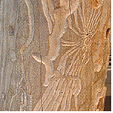 Borer Damage
Borer Damage 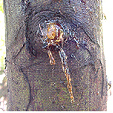 Resin oozing from a trunk
Resin oozing from a trunk
Susceptible Plants
There are many plants that are attacked by these pests including Banksia, Callistemon, Melaleuca, Lagerstroemia, Jacaranda species, and flowering stonefruit. Eucalyptus, Acacia species and many ornamental such as Acer species. Plants that are stressed, are particularly venerable.
Acacia and Eucalyptus species are attacked by Swift Moths and Wood Moths.
Acacia species are susceptible to attack from the Wattle Web-covering Borer (Cryptophasa rubescens), which weakens and causes die back of branches.
Acer platanoides is attacked by the Leaf Stalk Borer (Nepticula albostriella) that tunnels into the petiole of the leaf turning it blackish and also attacks the fruit.
Acer saccharinum is attacked by the Petiole Borer (Caulocampus acericaulis) which tunnels in the petioles. It generally attacks the leaves on the lower branches causing them to fall.
Acer species may also be attacked by several borers including the Flat Headed Borer (Chrysobothris femorata), a 25mm long lava of a coppered coloured beetle, that tunnels galleries under the bark girdling the trees The Sugar Maple Borer (Glycobius speciosus) which girdles branches killing them and the Leopard Moth (Zeuzera pyrina) lava that tunnels large holes into branches making them structurally weak. This lava can grow to 80mm long and 12mm thick overwintering in the tunnels.
Banksia species are attacked by the Banksia Web-covering Borer (Xylorycta strigata) a greenish lava up to 40mm long that tunnels down the centre of branch tips. The entrance is covered in silken web littered with faecal material and causes the death of the branchlets.
Betula and Populus species are attacked with the Bronze Birch Borer (Agrilus anxius) and heavy infestation may kill the tree. Populus species are also attacked by the Poplar Borer (Saperda calcarate).
Brachychiton species are attacked by the Kurrajong Weevil (Axionicus insignis) the lava of this plump greyish weevil is white and legless, entering the plant through wounds forming rounded tunnels that may girdle the tree, killing it.
Carya species are attacked by the Painted Hickory Borer (Megacyllene caryae). The adult dark brown beetle has obvious zig zag lines on its wing covers and the lava is cream coloured, both up to 20mm long. The lava tunnels the sapwood of living trees causing ring barking and also tunnels dead trees.
Cornus species are attacked by several borers such as the Flat Headed Borer (Chrysobothris femorata) and the Dogwood Borer (Thamnosphecia scitula).
Cupressus species are attacked by the Cypress Bark Beetle (Phloeosinus cupressi) causing the branches to turn brown and die off from the top or causing the leaves to wilt. On first indication of infestation selective prune off damaged areas or remove the tree.
Hakea sericea and other Hakea species are attacked by the Web-covering Borer (Neodrepta luteotactella). The larvae bore into the twigs and fruit forming a small covering of frass. This insect also infects Macadamia species. Hakeas are also attacked by several other web-covering borers.
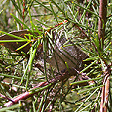 Hakea sericea
Hakea sericea
Pinus and Picea species are attacked by the White Pine Weevil (Pissodes strobi) in the northern hemisphere.
Samanea saman is attacked by the borer (Xystrocera globosa) which chews into the sap wood of stressed trees and can cause serious damage.
Sorbus aucuparia is attacked by the Round Headed Borer (Saperda candida) which forms galleries in the trunk at ground level, forming round holes in the bark.
Tilia species are attacked by the European Bark Borer (Chrysoclista linneela), which feeds on the bark and thew Linden Borer (Saperda vestita) that attacks the base of the trunk or roots.
Tsuga species are attacked by Spotted Hemlock Borer (Melanophila fulvoguttata).
Vaccinium ovatum is infested by the Azalea Stem Borer (Oberea myops). The yellowish lava of this beetle bores into the tips of stems during the flowering period and is up to 12mm (½in) long. It is also commonly found on Rhododenron species.
Control
Cultural Control
Larvae may be destroyed after exposure by pulling away the covering pad of frass, or by pushing a length of wire into the tunnel. Damaged branches may be removed. Improve the culture by feeding and watering the plant.
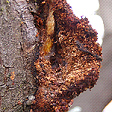 Frass due to the Fruit tree moth borer
Frass due to the Fruit tree moth borer
Biological Control
No effective biological control though certain species of trees exude gum or resin sealing the holes and limiting the activity of the larvae or causing its death.
Chemical Control
There is no satisfactory chemical control most borers of live wood.
Note
It is your responsibility by law to read & follow the directions on the label of any pesticide
DISEASE
NAME
Crown Gall
Agrobacterium and other species
Description
Bacterial problem that is associated with wounds, caused by insects or physical damage in plant tissues.
Symptoms
Soft galls appear on the roots, base and up the stem becoming hard with age. The plant responds by loosing vigour and may produce less flowers or fruit.
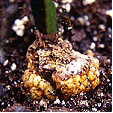
Source and Dispersal
The spores are found in the soil or are released from decaying galls and are spread by infested soil or plant material and contaminated tools.
Favoured Conditions
Continuous cultivation of infested plants allowing a build up of spores in the soil and poor propagation methods during grafting or handling transmits the disease.
Affected Plants
There are many species of woody plants that are affected these include, species in the Rosaceae family, Dahlias, Geraniums, Vitis and Brachychiton species.
Araucaria, Arbutus, Begonia, Chaenomeles, Corylus, Euonymus, Euphorbia, Leucanthemum, Protasparagus, Thunbergia and Wisteria species are infected by a simular crown-gall (Erwinia tumefaciens) which causes smooth swellings to appear on the roots and main stems of the host.
Large cactus species are attacked by the Crown Gall (Agrobacterium tumefaciens). It develops galls on segments and roots with some of the aerial galls attaining a diameter of over 600 mm. Root galls, become a spongy and may attain a diameter of 300 mm. Galls on aerial parts may be cut from the plant with some success. Control methods include not damaging the plant surface and any bacteria contaminated soil should not be used for propagation.
Sorbus aucuparia is seriously affected by this disease.
Non-chemical Control
Remove and destroy any infected plants and avoid replanting in the same area with susceptible species. Care should also be taken when selecting new plants that they are not infected, look for lumps at the base of the plant. Disinfect pruning or grafting tools to inhibit transmitting the disease.
A treatment of control is to dip seeds, cuttings and seedlings into a solution of a non-pathogenic strain of bacteria such as Agrobacterium rhizogenes before planting. This is commercially available under several brand names.
Chemical Control
There is no chemical control of this bacterial problem.
Note
Always read the label for registration details and direction of use prior to application of any chemicals.
Average Lowest Temperature : -1º C 30º F
USDA : 9, 10, 11, 12
This USDA (United States Department of Agriculture) hardiness zone chart can be used to indicate a plant’s ability to withstand average minimum temperatures. However, other factors such as soil type, pH, and moisture, drainage, humidity and exposure to sun and wind will also have a direct effect on your plant’s survival. Use this chart only as a guide, always keep the other factors in mind when deciding where, when and what to plant.
A plant's individual USDA zone can be found in the Plant Overview.
Region of origin
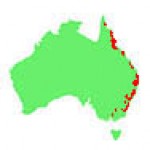
Australia, (Sydney, NSW to northern Queensland)
Climate Description
Warm to Sub-tropical
This overlaping zone has ample rain with high summer temeperatures and high humidity. Winters are mild. Pockets of sub-tropical climates exist within coastal warm temperate zones.
Frosts and droughts rarely occur along the coast.
Plant growth
Tropical and warm temperate native and exotic plants grow well.
| Dictionary | Growth Habit |
| Leaf Type | Botanic Flower Description |
| Leaf Shape | Flower Inflorescence |
| Leaf Arrangement | Fruit Type |
| Leaf Margin | Bark Type |
| Leaf Apex And Bases | Flower Description |